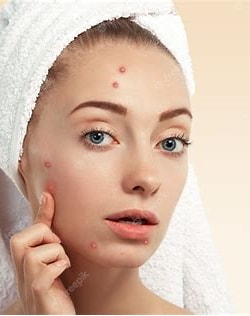
Understanding Adult and Menopausal Acne
Menopausal acne is more likely to be both painful and located on the body—especially the trunk. Getting a clear diagnosis helps us target the root causes and restore your skin’s natural glow.
Adult acne is defined medically as acne begining after age 25, though informally it’s often used to describe acne after age 40. Menopausal acne, on the other hand, presents during perimenopause—the transitional years around natural menopause (ave age 51.4)—so typically appears later.
Both types involve a similar dysfunction of the pilosebaceous unit:
-
Excess or altered sebum production
-
Thickened superficial skin layers
-
Pigment irregularities
-
Overgrowth of Cutibacterium acnes
-
Local inflammation and impaired skin immunity
In short, acne is an inflammatory disorder with multifactorial pathogenesis—many of our treatment strategies will improve both adult and menopausal types.
Contributing Factors
-
Hormonal changes: You may notice other symptoms of androgen excess as estrogen-to-androgen ratios shift. It can be from testosterone therapy when the levels are too high.
-
Stress: More closely linked to menopausal acne; mindfulness, breathwork, and yoga are invaluable. Try a class with one of our excellent instructors—or join me at Hatha Yoga & Fitness.
-
Body composition: Obesity contributes more to menopausal acne. Even modest improvements in lean body mass can benefit your skin.
-
Sun damage: Predisposes to both types. I recommend higher-grade medical sunscreens—schedule a consultation at Hada Cosmetic Medicine to find your ideal product.
-
Hair changes: Hair loss or unwanted hair growth (hirsutism) are more common with menopausal acne.
Diagnosis and Treatment
Lesion appearance can overlap, so diagnosis isn’t always straightforward. Both conditions can be resistant to standard therapies, but menopausal acne often responds better when underlying hormonal imbalances are addressed.
We suggest procedures, microbiome balancing face washes, and balancing hormones. One of the most effective tools we use for hormonally driven acne is Diindolylmethane (DIM)—a natural compound derived from cruciferous vegetables such as broccoli, kale, and Brussels sprouts. DIM helps restore hormone balance by blocking the conversion of testosterone to dihydrotestosterone (DHT), the potent androgen that increases sebum production and triggers inflammatory acne lesions. This is proven by cell culture and animal studies. By reducing DHT activity, DIM supports clearer skin, decreased oil production, and improved hormonal equilibrium. DIM also supports heart health.
It’s never too soon to get evaluated—schedule a consultation today and let’s get your skin back to healthy, confident radiance.

